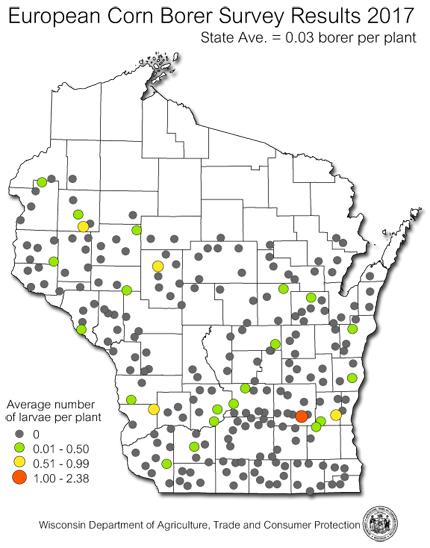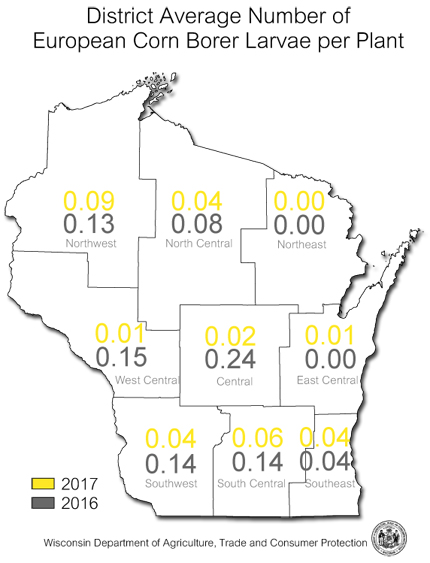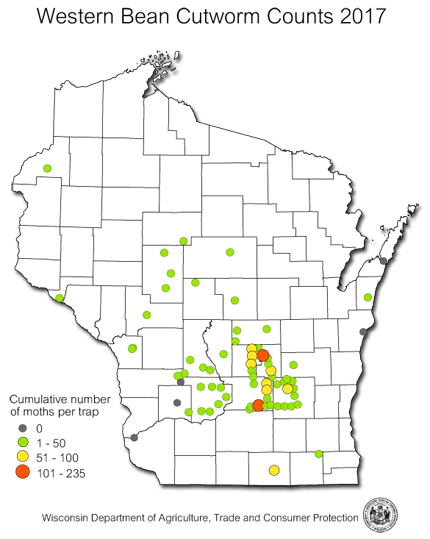
 |
|
|
Corn
Volume 62 Number 19 Date 11/09/2017 CORN ROOTWORM - Adult corn rootworm counts decreased to the lowest level since surveys for this pest began in Wisconsin in 1971. The annual survey conducted from July 28-August 16 found a state average of just 0.2 beetle per plant, less than half of last year's average of 0.5 per plant and far below the 0.75 beetle per plant economic threshold used to inform rootworm management decisions for the following season. Numbers declined across all nine crop districts as compared to 2016, with district averages ranging no higher than 0.3 per plant. Only 24 of the 229 (10%) cornfields sampled had above-threshold averages of 0.8-2.9 beetles per plant, while 54 (24%) had below-threshold averages in the range of 0.1-0.7 per plant. No corn rootworm beetles were observed in 151 (66%) of the fields. Reasons for the historic decrease in beetle abundance are unclear but likely include a combination of factors such as heavy spring rains that led to saturated soils during larval hatch in June, the significant use of pyramided Bt-rootworm (Bt-RW) hybrids, and the practice of overlaying soil insecticides on Bt-RW hybrids during planting. The unexpectedly low beetle pressure documented this season may have resulted in fewer eggs being deposited into cornfield soils, and an overall lower risk of larval root damage next summer. CORN EARWORM - The late-season monitoring survey captured a cumulative total of 2,760 moths in 15 traps. Nearly one-half of the moths (1,284) were collected at the Ripon location, most of which arrived during the last two weeks of September. Compared to 2016 when 6,402 moths were captured in 16 traps, this year's migration was much smaller, with the heaviest flights (>250 moths) limited to three sites in Columbia, Dodge and Fond du Lac counties. Twelve other pheromone traps in Dane, Grant, Manitowoc, Marathon, Rock, Vernon, Waushara and Wood counties all captured fewer than 100 moths from August through September. Corn earworm flights ended about October 9. EUROPEAN CORN BORER - Larval populations declined to 0.03 borer per plant this fall, tying 2012 and 2014 as the second lowest state average in the survey's 76-year history. The lowest recorded average of 0.02 larva per plant was documented in 2015. Minor population reductions from 2016 were found in six of the state's nine agricultural districts, while an insignificant increase was noted in the east-central area. The northeast and southeast district averages remained unchanged at 0.0 and 0.04 borer per plant, respectively. One hundred and ninety-six of the 229 (86%) fields examined showed no evidence of corn borer infestation. Results of the survey suggest that Wisconsin corn producers are maintaining a high Bt use rate which continues to provide overall effective suppression of European corn borer populations. BLACK CUTWORM - Many corn acres were under a high threat of larval infestation in May and June. Delayed spring tillage and planting, wet field conditions, and late weed control all favored oviposition and larval development, while repeated heavy flights of 200-635 moths per week throughout April and May signaled an elevated risk for widespread, damaging cutworm problems. Larval feeding became noticeable in corn by early June, but most injury observed by DATCP surveyors was light and involved less than 1-2% of plants. Although the spring cumulative count of 3,228 moths in 45 traps was substantially larger than last year's capture of 1,835 moths in 43 traps, economic injury (>3% of plants damaged) was rare. WESTERN BEAN CUTWORM - Moth counts increased from the previous year and larval injury to corn was slightly more common this season. The state trapping program captured a total of 1,856 moths in 70 traps (27 per trap average) from June 18-August 23, which was larger than last year's 1,530 moths in 75 traps (20 per trap average) and also higher than the 13-year survey average of 23 moths per trap. Larval infestations were found in approximately 10% of the 458 corn sites surveyed in August and September, compared to 9% last year. -- Krista Hamilton, DATCP Entomologist PIGWEED - Surveys for waterhemp, Palmer amaranth, and other pigweed species in field crops were conducted between late July and October of 2017. Of the 13 pigweeds (Amaranthus spp.) found in Wisconsin, Palmer amaranth and waterhemp are of greatest concern due to their aggressiveness and documented resistance to several herbicides. DATCP specialists surveyed a total of 579 fields (384 corn and 195 soybean), 27 of which were positive for waterhemp. The distribution of waterhemp in Wisconsin currently includes 54 counties in the southern two-thirds of the state, with St. Croix County added in 2017. Palmer amaranth was not found during the DATCP survey this season, but at least 10 separate populations have been confirmed by the UW at sites in Adams, Dane, Grant, Green, Iowa, Rock, Sauk and Waushara counties. -- Tracy Schilder, DATCP Pest Survey Program SEED CORN CERTIFICATION - Eleven growers in nine counties participated in seed corn field inspections for export certification in 2017. Samples from 52 fields were tested in the laboratory for the bacterial diseases Goss's wilt and Stewart's wilt. Six samples (12%) were diagnosed with Goss's wilt, a decline from 14% in 2016 and 39% in 2015. Counties in which Goss's wilt was found were Dane, Fond du Lac and Eau Claire. Stewart's wilt was not detected in any seed field this year and has not been observed or reported in Wisconsin corn since 2010. All corn leaf samples were also checked for viruses, including High Plains virus, wheat streak mosaic virus, and maize chlorotic mottle virus. None were detected. XANTHOMONAS LEAF BLIGHT - Corn leaf samples showing symptoms of leaf blight were collected from 125 fields between July 21 and September 29 and tested for Xanthomonas vasicola pv vasculorum at the Plant Industry Lab. Xanthomonas leaf blight was not detected in any of the samples. Other corn foliar diseases found during the survey, in order from the most to the least common, were: common rust, gray leaf spot, northern corn leaf blight, northern corn leaf spot, and anthracnose. A few samples also tested positive for Septoria leaf blotch, Phyllosticta leaf spot, Phaeosphaeria leaf spot, and smut. Xanthomonas leaf blight was first confirmed in the U.S. on August 26, 2016 and has to date been identified in nine states: Colorado, Illinois, Iowa, Kansas, Minnesota, Nebraska, South Dakota, Texas and Oklahoma. -- Anette Phibbs, DATCP Plant Pathologist 





|
|
|